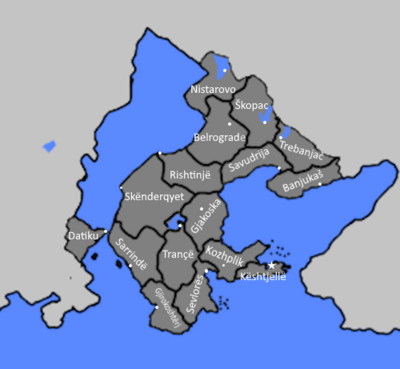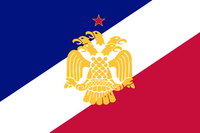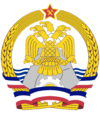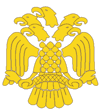Skiperia
This article is incomplete because it is pending further input from participants, or it is a work-in-progress by one author. Please comment on this article's talk page to share your input, comments and questions. Note: To contribute to this article, you may need to seek help from the author(s) of this page. |
Skiperian Federation Федерата ШЌиптарие (Federata Skqitarie) - Skiperian Шкиртарска Федерације (Skiptarska Federachije) - Malizian | |
|---|---|
| Motto: Вӗллаи ҙе Башким нӗ Луфтӗ (Skiperian) Братство и јединство у борби (Malizian) Brother and Unity in Struggle | |
| Anthem: Ќӗндроjмӗ си малет We Stand Like the Mountains Интернационале The Internationale | |
 Rajonet Map of Skiperia | |
| Capital and largest city | Kështjellë |
| Official languages | Skiperian |
| Recognised national languages | Malizian |
| Recognised regional languages | Datian Kodrenish |
| Ethnic groups | Skiperian Malizian Datian Kodrenish |
| Demonym(s) | English: Skiperian Skiperian: Shqiptarie Malizian/Kodrenish: Skipernac |
| Government | Federal Parliamentary Mauryist Republic |
| Veror Shkelyim | |
• Premier | Liliana Cumani |
| Legislature | Skiperian People's Assembly |
| Establishment | |
• Independence | 1047 CE |
• First Assembly | 1456 CE |
• Midhan Skedos Dictatorship | 1963 CE |
• People's Republic | 2013 CE |
| Population | |
• 2020 estimate | |
• 2022 census | |
| GDP (PPP) | 2022 estimate |
• Total | 940 Billion $ |
• Per capita | 37,645 $ |
| GDP (nominal) | 2022 estimate |
• Total | 470 Billion $ |
• Per capita | 19,362 |
| Gini (2022 estimate) | 35 medium |
| HDI (2022 estimate) | 0.743 high |
| Currency | Lek (SKL) |
| Date format | dd.mm.yyyy |
| Driving side | right |
| ISO 3166 code | SK |
| Internet TLD | .sk |
Skiperia (Skiperian: ШЌиптарие, Malizian: Скипериа, officially known as the Skiperian Federation) is a socialist state in southern Maris, emerging after the success of the socialist revolution in the country in 2013. It is situated along a peninsula in between the Jadranskian Sea to the East and the Karavastaskan Gulf to the West, separated from the rest of Maris by the Bjekët Mountains. Much of the population lies along the eastern coast, including its capital and largest city, Kështjellë. The country has historically played a major role in the region, being an important hub for trade and commerce along the sea towards Chora. The end of the golden era led the country into economic ruin and decay, Although it has for the past hundred years pursued a policy of isolation and neutrality, the beginning of the 20th Century has led the country to open up once again to the outside world. It has begun to forge ties with much of the socialist world, developing close ties with its neighbor of Chora. The country continues attempt to modernize and develop, a process greatly harmed by ultranationalist and royalist terrorist forces in the North, including the LRM.
Etymology
The region has gone by numerous names throughout its history. The Ancient Chorans called the land "προβάτων", meaning "Land of Sheep", due to the large herds of sheep that roamed the hillside. Under the Lancian Empire, the territory name was lancinized as Provatonia. The Name "Skiperia" has been in use in some form since the country's original independence in 1047, referencing the symbol of the first Sudimtar Gjegj Osekuti's tribe - the Osekut. Ancient Skiperian legend tells of the guidance of God, in the form of an eagle, descending from the heavens to instruct Gjegj to paint a five-headed eagle (Скипонjе/Skqiponje, as it is called in their language) on his shield. It was Osekuti's soldiers that led to the eventual victory of the 5 tribes in the Battle of the Vojsa. After this, Osekuti converted his people to Lumenism and led them eventually gain complete independence from Lancia in 1047. The Modern name "ШЌиптарие" means "Land of the Eagles".
History
Ancient Times
Settlements have existed in the region now known as Skiperia for thousands of years. Several tribal fiefdoms controlled the interior of the country, including the ancestors of the 5 tribes that led the wars of independence. Ancient artifacts found along the Karavastaskan Gulf point to trading settlements as far back as 4000 BCE. Several Choran colonies were also found along the southern coast, including the settlement of Vounopolis (which would later become the capital of Кӗштйеллӗ (Kështjellë)), as well as Díavlos (later becoming the strategic port city of Севлорӗс (Sevlorës)). These colonies and trading centers would form an important economic hub for the continent.
The Rise of Lancia
The various separate tribes of Skiperia found themselves united under foreign rule when the Lancian Empire occupied the entire region in 107 BCE, following a swift military campaign against the tribes. The tribes had been raiding Lancian shipping and trade, and it was thought that the defeat of the tribes would pacify the region. Thus began over a thousand years Lancian rule over their province of Provatonia. Under Lancian rule, road networks would be vastly expanded, and Sevlorës would become a bustling trade hub. It would also see large migrations of Skiperians to the other side of the Strait of Datia, and the settlement of Datium (later, Datiku). The Lumenites entered the Skiperian peninsula in 103 CE from Chora, and with them, came the first writing system. St. Pagoniadis adapted the Choran alphabet to fit the Skiperian language, leading to the development of the first Skiperian script. This would greatly increase literacy in the towns and cities along the coast, although few converted to the religion and instead prefered the traditional Skiperian faith. The Lancian Empire cracked down on these missionaries too, leading to the martyrdom of St. Pagoniadis in 142. Upon the adoption of Lumenism by the country in 1039, St. Pagoniadis would be declared the patron saint of the Skiperians. Around the beginning of the 800s, numerous nomadic tribes migrated across the Bjekët Mountains, crossing around Lake Škopad. Fleeing the Mađazar invasions, they would rapidly enter into Lancian territory. They would gradually begin to spread along much of the northern highlands of the Skiperian peninsula. These tribes would eventually settle down, and would develop into the Malizians. They would also bring with them their traditional Jatrebianist faith, which would largely last with them into the 21st century. Several Skiperian tribes in the north would also adopt many aspects of the faith, blurring the line between traditional Skiperianist religion and Jatrebianism.
The First Kingdom
As the Lancian Empire declined in influence in the region, the various Skiperians began to desire further and further national autonomy. It was under this climate that Gjegj Osekuti, leader of the Osekut tribe, would enter the scene. He would, after several rounds of negotiations, bring the various tribes together at the Council of Trançë in 1024. There, the various chiefs elected Gjegj "Sudimtar", or leader. The council also voted then to declare independence from the Lancian Empire, beginning the war of independence. Legend states the Gjegj was given a vision from God in 1047, instructing him to paint a Five-Headed Eagle on his shields before battle. His tribe would be instrumental at the Skiperian victory at the Battle of the Vojsa that same year, which would drive the Lancian forces into the northern half of the peninsula, into the areas primarily inhabited by more loyal Malizians. The Osekut tribe would, as a result, be the first of the Skiperian tribes to convert to Lumenism. The coronation of Gjegj Osekuti as "King of the Eagle-men" (Мбрети и ШЌипонjӗс in Skiperian) would mark the beginning the Skiperian state, and the adoption of their identity as Skiperians (Children of the Eagles). The Five-headed eagle was adopted as the national symbol of the young state, with it continuing to hold almost mythical significance to the Skiperian people to this day. Gjegj Osekuti would also make the pivotal decision of adopting Lumenism as the official state religion, and his subsequent enforcement of the tribal conversions to the faith.
The Osekuti dynasty would lead the nation into its first age, one characterized by Lumenization of society, expansionism, and militarism. This would begin with the establishment of the royal court in 1057 at Kështjellë, and the begining construction of the fortified city. The kings would wage numerous wars against the Lancian Empire to the north, eventually unifying the entirety of the Skiperian peninsula under the kingdom by the end of the 1200s. This would also bring hundreds of thousands of Malizians under their rule, who had continued to practice their traditional faith since their migration. Local missionaries developed a written form of the Malizian language with the Skiperian Alphabet, to facilitate their conversion to Lumenism and their eventual integration into Skiperian society. Those who converted were given numerous privileges and rights. The majority however did not convert, leading to their persecution and discrimination. A state tax was instituted against those who continued to practice faiths other than Lumenism, and Lumenism was established as a requirement for civil service. This period would also mark the decline of tribal politics, with appointed dukes and counts of the five tribes taking positions in governing rather than traditional familial chiefs. These dukes and counts built numerous fortifications to solidify their control, and encouraged the end of migratory practices (still practiced by northern Skiperians and Malizians) in favor of collective farms and villages. Many of these fortifications remain to this day, forming the old towns of many regional capitals.
The Skiperian Golden Age
Decline
The Skedos Regime
The Revolution
Politics

|

|
| Bashar al-Assad |
Hussein Arnous |
The revolution of 2013 radically changed the political structure of the Skiperian State. Now, Skiperia is officially a parliamentary republic, with a president serving as the head of state. The constitution serves as the guiding document for the new state, delegating various powers and authorities to each of the three branches. The government nominally allows for any party to run for the position of President, but the position holds no real authority, only serving as a ceremonial role. All power is officially held by the Skiperian People's Assembly, with the premier acting as the Head of Government. The Premier in turn appoints the members of the Council of Ministers, which puts the policies and laws adopted by the SPA into practice. The Skiperian Supreme Court mainly holds the responsibility of determining the constitutionality of laws and executive decisions by the Council of Ministers, but remains in effect subordinate to the Skiperian People's Assembly.
The Skiperian People's Assembly is divided into two chambers, the Dhoma e Popullit (People's Chamber) and the Dhoma e Rajoneve (Chamber of Rajonets). The People's Chamber is elected from each region by population, and has the responbility of electing the Premier from its membership. Although not officially required to do so, the premier has traditionally been elected from the leadership of the Skiperian People's Front, which holds a plurality of seats in the People's Chamber. One seat is alocated for every 100,000 people, meaning there is a grand total of 243 seats. The Chamber of Rajonets is elected by each Legjislativi Rajonal, or Rajonet Legislature. Each Rajonet elects two members, for a cumulative total of 32 members. The People's Chamber holds the majority of decision making power, although the approval of the Chamber of Rajonets is required for major budgetary or military decisions. This gives the Rajonets a larger say in major administrative decisions, and allows the Malizian and Datian minorities to prevent any major disruptions or overreaches of power from the Skiperians. Elections are held for both Chambers every 4 years, with the last elections being held in 2021.
All parties in the Skiperian People's Assembly, in both Chambers, form a part of the National Front for a Democratic Skiperia, a broad coalition of parties that collectively govern in the Dhoma e Popullit. This includes a variety of pro-capitalist parties, although these make up only a small section of the SPA and hold limited government influence. Also included are parties representing minority ethnic groups, with the Malizian Peoples' Revolutionary Party holding a plurality of support in all majority Malizian states.
Military
Administrative Divisions
The Kodrenish remain the only ethnic group without representation in the Chamber of Rajonets. Local Kodrenish activists have been pushing for their own rajonet made from territory of the Nistarovo and Skopac rajonets. However, attempts at putting this change into legislative action have been stalled in the KPA, with MPRF and KPF leaders divided on the topic. It is expected that a compromise will be made soon, with Premier Brajko Todorović of the MPRF having voiced his support for his support for a division of the region in September 2023. A new draft resolution is expected to be debated in January during the next session of the People's Chamber.





